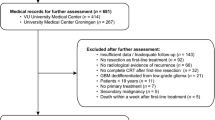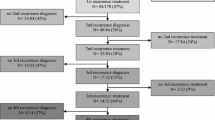Abstract
Optimal treatment of recurrent glioblastoma multiforme (rGBM) in elderly and/or frail patients remains virtually unexplored, the best supportive care (BSC) only is routinely administered due to the fatal prognosis. We evaluated the impact of different treatment methods on post-progression survival (PPS) and overall survival (OS) of such patients. Data from 98 elderly and/or frail rGBM patients, treated initially with 1-week or 3-week radiotherapy (RT) within the phase III IAEA study (2010–2013), were analyzed. KPS at relapse and salvage treatment methods were recorded. Kaplan–Meier method was used to estimate PPS and OS for different treatment modalities. Eighty-four patients experienced recurrence: 47 (56 %) received BSC, 21 (25 %)—chemotherapy (CHT), 8 (9.5 %)—surgery, 3 (3.5 %)—RT, for 5 (6 %) the data was unavailable. Median OS from randomization for all 84 patients was 35 weeks: 55 versus 30 weeks for any treatment versus BSC, p < 0.0001. Median PPS was 15 weeks: 23 weeks with any treatment versus 9 weeks with BSC, p < 0.0001. For local treatment (surgery and/or RT) median PPS was 51 versus 21 weeks for CHT, p = 0.36. In patients with poor KPS (≤60) at relapse median PPS was 9 weeks with BSC versus 21 weeks with any treatment, p = 0.014. In poor KPS patients median PPS for local treatment was 14 weeks versus 21 weeks with CHT, p = 0.88. An active therapeutic approach may be beneficial for selected elderly and/or frail rGBM patients. Poor KPS patients may also benefit from active treatment, but there is no benefit of local treatment over CHT.



Similar content being viewed by others
References
Boyle P, Maisonneuve R, Muir C (1990) Is the increased incidence of primary brain tumours in the elderly real? J Natl Cancer Inst 82:1594–1596
Greig N, Ries L, Yanick R et al (1990) Increasing annual incidence of primary malignant brain tumours in the elderly. J Natl Cancer Inst 82:1621–1624
Hess KR, Broglio KR, Bondy ML (2004) Adult glioma incidence trends in the United States, 1977-2000. Cancer 101:2293–2299
Ferguson M, Rodrigues G, Cao J et al (2014) Management of high-grade gliomas in the elderly. Semin Radiat Oncol 24:279–288
Ohgaki H, Dessen P, Jourde B et al (2004) Genetic pathways to glioblastoma: a population-based study. Cancer Res 64:6892–6899
Wrensch M, Minn Y, Chew T et al (2002) Epidemiology of primary brain tumors: current concepts and review of the literature. Neuro Oncol 4:278–299
Laperriere N, Weller M, Stupp R et al (2013) Optimal management of elderly patients with glioblastoma. Cancer Treat Rev 39:350–357
NCCN Clinical Practice Guidelines in Oncology. Central Nervous System Cancers. Version 1.2015. Available from: http://nccn.org/
Li J, Wang M, Won M et al (2011) Validation and simplification of the Radiation Therapy Oncology Group recursive partitioning analysis classification for glioblastoma. Int J Radiat Oncol Biol Phys 81:623–630
Keime-Guibert F, Chinot O, Taillandier L et al (2007) Association of French-speaking neuro-oncologists. Radiotherapy for glioblastoma in the elderly. N Engl J Med 356:1527–1535
Yin AA, Zhang LH, Cheng JX et al (2013) Radiotherapy plus concurrent or sequential temozolomide for glioblastoma in the elderly: a meta-analysis. PLoS One 8:e74242
Roa W, Kepka L, Kumar N, et al. (2015) An IAEA randomized phase III study of radiation therapy in elderly and/or frail patients with newly diagnosed glioblastoma multiforme. J Clin Oncol 2015, JCO.2015.62.6606; published online on September 21, 2015
Nieder C, Grosu AL, Molls M (2000) A comparison of treatment results for recurrent malignant gliomas. Cancer Treat Rev 26:397–409
Easaw JC, Mason WP, Perry J et al (2011) Canadian Glioblastoma Recommendations Committee. Canadian recommendations for the treatment of recurrent or progressive glioblastoma multiforme. Curr Oncol 18:e126–e136
Barker FG 2nd, Chang SM, Gutin PH et al (1998) Survival and functional status after resection of recurrent glioblastoma multiforme. Neurosurgery 42:709–723
Pinsker M, Lumenta C (2001) Experiences with reoperation on recurrent glioblastoma multiforme. Zentralbl Neurochir 62:43–47
Quick J, Gessler F, Dützmann S et al (2014) Benefit of tumor resection for recurrent glioblastoma. J Neurooncol 117:365–372
Kim HR, Kim KH, Kong DS et al (2015) Outcome of salvage treatment for recurrent glioblastoma. J Clin Neurosci 22:468–473
Park JK, Hodges T, Arko L et al (2010) Scale to predict survival after surgery for recurrent glioblastoma multiforme. J Clin Oncol 28:3838–3843
Taal W, Oosterkamp HM, Walenkamp AM et al (2014) Single-agent bevacizumab or lomustine versus a combination of bevacizumab plus lomustine in patients with recurrent glioblastoma (BELOB trial): a randomised controlled phase 2 trial. Lancet Oncol 15:943–953
Wick W, Platten M, Meisner C et al (2012) Temozolomide chemotherapy alone versus radiotherapy alone for malignant astrocytoma in the elderly: the NOA-08 randomised, phase 3 trial. Lancet Oncol 13:707–715
Malmström A, Grønberg BH, Marosi C et al (2012) Temozolomide versus standard 6-week radiotherapy versus hypofractionated radiotherapy in patients older than 60 years with glioblastoma: the Nordic randomised, phase 3 trial. Lancet Oncol 13:916–926
NCT00482677: A randomized phase III study of temozolomide and short-course radiation versus short-course radiation alone in the treatment of newly diagnosed glioblastoma multiforme in elderly patients. https://clinicaltrials.gov/ct2/show/NCT00482677
Author information
Authors and Affiliations
Corresponding author
Ethics declarations
Conflict of interest
The authors declare that they have no conflict of interest.
Rights and permissions
About this article
Cite this article
Socha, J., Kepka, L., Ghosh, S. et al. Outcome of treatment of recurrent glioblastoma multiforme in elderly and/or frail patients. J Neurooncol 126, 493–498 (2016). https://doi.org/10.1007/s11060-015-1987-7
Received:
Accepted:
Published:
Issue Date:
DOI: https://doi.org/10.1007/s11060-015-1987-7




